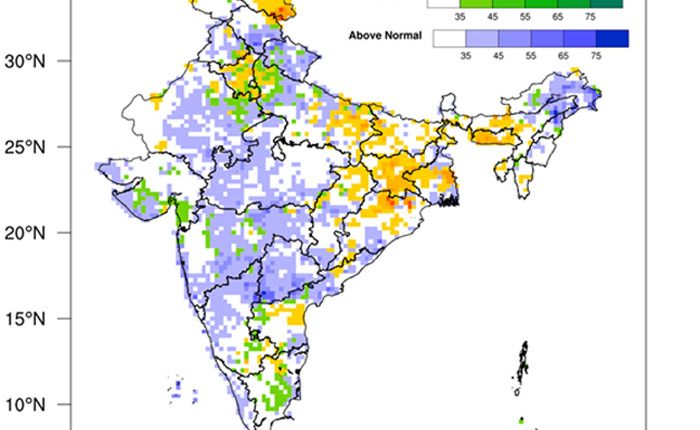Summary of the Forecast for the 2021 southwest monsoon Rainfall
| New Delhi/Kalinga Voice : Southwest monsoon seasonal (June to September) rainfall over the country as a whole is most likely to be normal (96 to 104 % of Long Period Average (LPA)).Quantitatively, the monsoon seasonal (June to September) rainfall is likely to be 98% of the Long Period Average (LPA) with a model error of ± 5%. The LPA of the season rainfall over the country as a whole for the period 1961-2010 is 88 cm.Neutral ENSO conditions are prevailing over the Pacific Ocean and Neutral Indian Ocean Dipole (IOD) conditions are prevailing over the Indian Ocean. The latest global model forecast indicates neutral ENSO conditions are likely to continue over the equatorial Pacific and negative IOD conditions are likely to develop over the Indian Ocean during the ensuing monsoon season. As sea surface temperature (SST) conditions over the Pacific and the Indian Oceans are known to have strong influence on Indian monsoon, IMD is carefully monitoring the evolution of sea surface conditions over these Ocean basins.IMD will issue the updated forecasts in the last week of May2021. In addition to update for the April forecast, forecasts for monsoon season (June-September) rainfall for four homogenous regions and forecast for the month of June also will be issued. |
- Background
Since 2003, India Meteorological Department (IMD) has been issuing the operational long-range forecast (LRF) for the southwest monsoon season (June-September) rainfall averaged over the country as a whole in two stages. The first stage forecast is issued in April and the second stage or update forecast is issued by the end of May. These forecasts are prepared using the state-of-the-art Statistical Ensemble Forecasting system (SEFS) that was developed indigenously by IMD. In the second stage, in addition to an update for April forecast, additional forecasts for monthly rainfall for July and August for the country as a whole and forecasts for seasonal rainfall (June to September) for four homogenous regions of India are also issued. Since 2017, IMD has been also using a high-resolution dynamical global Climate Forecasting System (CFS), which was developed under the Monsoon Mission of the Ministry of Earth Sciences (MoES).
- New Forecasting Strategy
There have been demands from different users and government authorities for forecasts of spatial distribution of seasonal rainfall along with the regionally averaged rainfall forecasts for better regional level planning of activities. For this specific purpose, Office of Climate Research & Services, IMD, Pune has now developed a Multi-Model Ensemble (MME) forecasting system based on coupled global climate models (CGCMs) from different global climate prediction and research centers including the Monsoon Mission CFS (MMCFS) being used by IMD. Multi-Model Ensemble (MME) is a universally accepted technique, which is used to improve skill of forecasts and reduce forecast errors when compared to a single model-based approach. The performance improvements are completely attributed to the collective information of all models used in the MME forecasting system.
For the first stage forecast, the existing statistical forecasting system and the new MME based forecasting system are used to generate forecasts. The MME based forecasting system also will be used in the second stage forecasts in May for generating probabilistic forecasts for the country as a whole and four homogenous regions of India.
For generating monthly forecasts, IMD will now use a dynamical MME framework instead of present statistical models. Monthly probabilistic forecast for all four months (June to September) will be prepared during the last week of previous month using the MME forecasting system.
IMD has also been making efforts to develop a separate forecast for the Monsoon Core Zone (MCZ), which represents most of the rainfed agriculture region in the country. A separate forecast for the MCZ will be more useful for agricultural planning and crop yield estimation etc. In the second stage forecast in May, IMD will issue a separate probabilistic forecast for the MCZ, based on MME system and a new statistical model.
- Forecast for the 2021 Southwest monsoon Season (June–September) rainfall over the country as a whole
3a.Forecast Based on Operational Statistical Ensemble Forecasting System (SEFS)
The forecast based on SEFS suggests that quantitatively, the monsoon seasonal rainfall is likely to be 98% of the Long Period Average (LPA) with a model error of ± 5%. The LPA of the season rainfall over the country as a whole for the period 1961-2010 is 88 cm.
The 5 category probability forecasts for the Seasonal (June to September) rainfall over the country as a whole based on the SEFS forecast are given below, which suggests maximum probability for monsoon seasonal rainfall to be normal (96-104% of LPA).
| Category | Rainfall Range(% of LPA) | Forecast Probability (%) | ClimatologicalProbability (%) |
| Deficient | < 90 | 14 | 16 |
| Below Normal | 90 – 96 | 25 | 17 |
| Normal | 96 -104 | 40 | 33 |
| Above Normal | 104 -110 | 16 | 16 |
| Excess | > 110 | 5 | 17 |
3. b. Forecast based on the Multi Model Ensemble Forecasting System
For generating the MME forecast for 2021 southwest Monsoon season rainfall, March initial conditions have been used. Climate models with the highest forecast skills over the Indian monsoon region including MMCFS have been used to generate MME forecasts.
The MME forecast also suggests that the monsoon rainfall during the 2021 monsoon season (June to September) averaged over the country as a whole is likely to be normal (96-104% of LPA).
The spatial distribution of probabilistic forecasts for tercile categories (above normal, normal and below normal) for the seasonal rainfall (June to September) is shown in Fig.1.The spatial distribution suggests either normal or above normal probability is likely over most parts of the country.
- Sea Surface Temperature (SST) Conditions in the equatorial Pacific & Indian Oceans
La Niña conditions (colder than normal SST over the equatorial Pacific) developed during second part of the previous year, which peaked in November. However, La Nina conditions over the equatorial Pacific started weakening in the early part of 2021 and conditions are now moving towards ENSO neutral conditions. Subsurface temperatures over the equatorial Pacific have substantially warmed and atmospheric patterns reflect neutral ENSO conditions. The latest MMCFS and other global model forecast indicate further warming trends and retuning of ENSO neutral conditions in the early part of the upcoming monsoon season.
At present, neutral Indian Ocean Dipole (IOD) conditions are prevailing over Indian Ocean. The latest forecast from the MMCFS and other global models together indicate that neutral IOD conditions are likely to turn into negative IOD conditions during the ensuing monsoon season.
.

